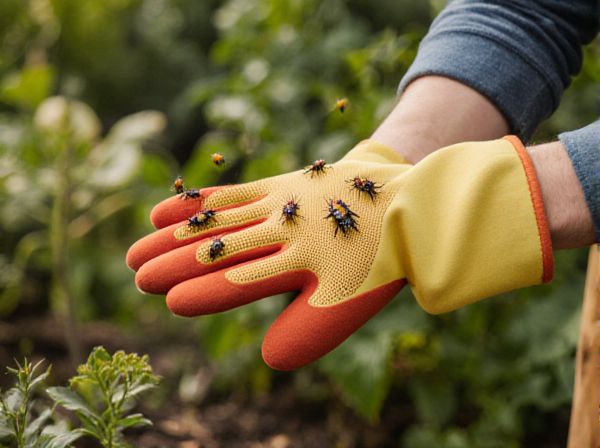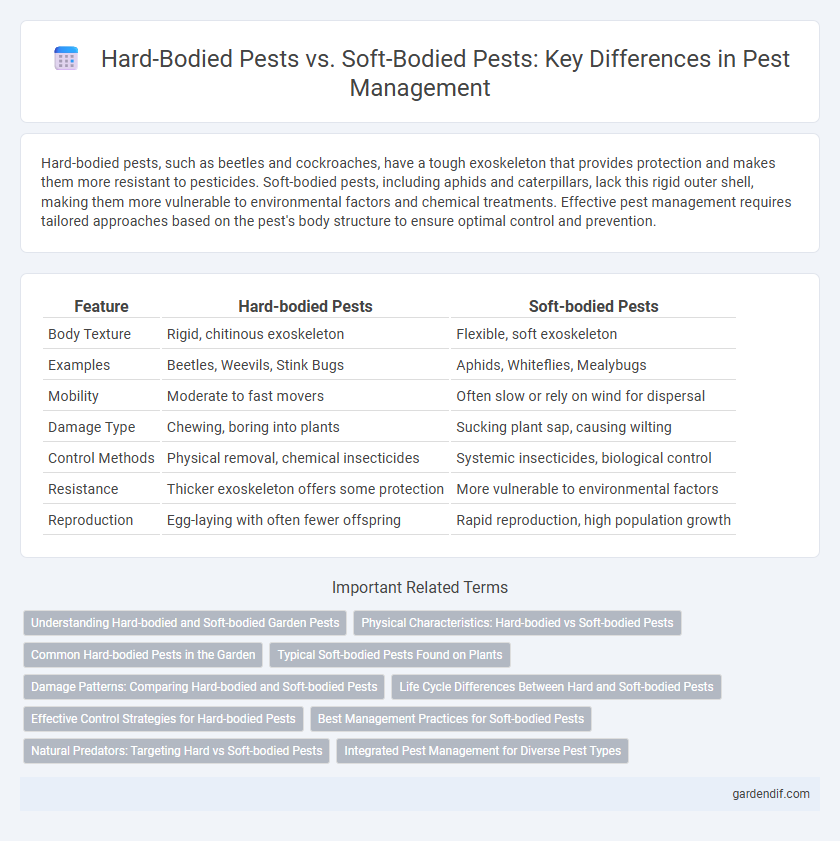
Hard-bodied pests vs Soft-bodied pests Illustration
Hard-bodied pests, such as beetles and cockroaches, have a tough exoskeleton that provides protection and makes them more resistant to pesticides. Soft-bodied pests, including aphids and caterpillars, lack this rigid outer shell, making them more vulnerable to environmental factors and chemical treatments. Effective pest management requires tailored approaches based on the pest's body structure to ensure optimal control and prevention.
Table of Comparison
| Feature | Hard-bodied Pests | Soft-bodied Pests |
|---|---|---|
| Body Texture | Rigid, chitinous exoskeleton | Flexible, soft exoskeleton |
| Examples | Beetles, Weevils, Stink Bugs | Aphids, Whiteflies, Mealybugs |
| Mobility | Moderate to fast movers | Often slow or rely on wind for dispersal |
| Damage Type | Chewing, boring into plants | Sucking plant sap, causing wilting |
| Control Methods | Physical removal, chemical insecticides | Systemic insecticides, biological control |
| Resistance | Thicker exoskeleton offers some protection | More vulnerable to environmental factors |
| Reproduction | Egg-laying with often fewer offspring | Rapid reproduction, high population growth |
Understanding Hard-bodied and Soft-bodied Garden Pests
Hard-bodied garden pests, such as beetles and weevils, possess a tough exoskeleton that provides protection and makes them more resistant to pesticides. Soft-bodied pests like aphids, caterpillars, and slugs have flexible bodies and are often more vulnerable to environmental factors but can multiply rapidly and damage plants quickly. Effective pest management requires identifying these pests accurately, as treatments vary significantly between hard-bodied and soft-bodied species.
Physical Characteristics: Hard-bodied vs Soft-bodied Pests
Hard-bodied pests possess a tough, rigid exoskeleton that provides protection and structural support, commonly found in beetles and certain ants. Soft-bodied pests, such as aphids and caterpillars, have flexible and softer outer layers, making them more susceptible to environmental hazards but often more agile. The distinction in physical characteristics influences pest control methods, as hard-bodied pests typically require stronger insecticides, while soft-bodied pests may be more vulnerable to biological control agents.
Common Hard-bodied Pests in the Garden
Common hard-bodied pests in the garden include beetles, weevils, and certain types of ants, characterized by their tough exoskeletons that protect them from predators and environmental conditions. These pests often cause significant damage by chewing on leaves, stems, and roots, leading to reduced plant vitality and yield. Effective management involves physical removal, use of insecticidal soaps, and encouraging natural predators like birds and parasitic wasps.
Typical Soft-bodied Pests Found on Plants
Typical soft-bodied pests found on plants include aphids, whiteflies, spider mites, and mealybugs, all characterized by their vulnerable exoskeletons that require protective measures for control. These pests often cause damage by sucking sap from leaves and stems, leading to wilting, yellowing, and reduced plant vigor. Effective management strategies involve biological controls like predatory insects, insecticidal soaps, and regular monitoring to prevent infestations from spreading.
Damage Patterns: Comparing Hard-bodied and Soft-bodied Pests
Hard-bodied pests, such as beetles and weevils, cause structural damage by boring into wood, crops, and stored products, often leaving behind visible holes and frass. Soft-bodied pests like aphids and caterpillars tend to damage plants by feeding on leaves and stems, resulting in discoloration, wilting, and distorted growth. Understanding the distinct feeding behaviors and damage patterns aids in accurate pest identification and effective management strategies.
Life Cycle Differences Between Hard and Soft-bodied Pests
Hard-bodied pests such as beetles and ticks undergo complete metamorphosis with distinct egg, larva, pupa, and adult stages, while soft-bodied pests like aphids and mites often experience incomplete metamorphosis, lacking a pupal stage. The duration of each life stage varies significantly, with hard-bodied pests typically having longer development periods compared to rapid generational turnover in soft-bodied pests. These life cycle differences impact pest management strategies, as hard-bodied pests may require targeted treatments at specific developmental stages, whereas soft-bodied pests demand continuous monitoring due to faster reproduction rates.
Effective Control Strategies for Hard-bodied Pests
Hard-bodied pests, such as beetles and cockroaches, require control strategies that target their tough exoskeletons, often involving residual insecticides and mechanical barriers like traps and seals to prevent entry. Effective management includes habitat modification to reduce moisture and food sources, alongside regular monitoring to detect infestations early. Integrated Pest Management (IPM) combining chemical treatments with sanitation practices ensures sustained control while minimizing resistance development.
Best Management Practices for Soft-bodied Pests
Soft-bodied pests such as aphids, whiteflies, and spider mites require integrated pest management strategies emphasizing biological control and selective insecticides to minimize crop damage while preserving beneficial insects. Regular monitoring and early detection enable targeted interventions using natural predators like lady beetles and predatory mites, reducing pesticide reliance. Implementing cultural practices such as crop rotation and maintaining plant health further enhances resistance to infestations and disrupts pest life cycles effectively.
Natural Predators: Targeting Hard vs Soft-bodied Pests
Natural predators like lady beetles and lacewings primarily target soft-bodied pests such as aphids and scale insects, providing effective biological control in gardens and crops. Hard-bodied pests, including beetles and weevils, are often controlled by ground beetles and predatory wasps, which have adapted to overcome their tougher exoskeletons. Integrating these natural predators into pest management strategies enhances sustainable control by specifically targeting the vulnerabilities of hard-bodied and soft-bodied pest populations.
Integrated Pest Management for Diverse Pest Types
Hard-bodied pests such as beetles and cockroaches exhibit durable exoskeletons that require targeted control methods within Integrated Pest Management (IPM) strategies, emphasizing mechanical removal and insecticides with residual activity. Soft-bodied pests, including aphids and spider mites, often demand biological controls like natural predators and selective acaricides to minimize chemical impact while maintaining crop health. Effective IPM for diverse pest types hinges on accurate pest identification, habitat modification, and combining cultural, biological, and chemical tactics tailored to the pest's morphology and life cycle.
Hard-bodied pests vs Soft-bodied pests Infographic

 gardendif.com
gardendif.com